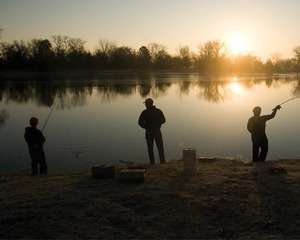Unlike hunting seasons, fishing never really ends here in Kansas. Yes, different times of the year bring with them differing success rates for different species, but there is good fishing to be had year around here in the sunflower state if you know where to go. The Kansas Dept of Wildlife, Parks and Tourism puts together and maintains fishing reports and fishing forecasts to help you with that. I spoke with the KDWPT Fisheries Biologist in my area, Bryan Sowards and got a crash course in reading and interpreting their fishing reports and forecasts and learned more about how they put them together.
Kansas fishing reports and forecasts are found on the website, www.ksoutdoors.com Fishing reports are simply information gathered by biologists from fisherman, marinas etc. at each lake and reservoir about how best to catch each species of fish in that impoundment. FISHING REPORTS are updated weekly from March through October as information is received. Fish sampling occurs on all Federal Reservoirs and State Lakes, and on some community owned lakes and ponds, and annual FISHING FORECASTS are generated from that data.
There are three ways fish in lakes and reservoirs are sampled to obtain information for annual fishing forecasts. In late October large hoop nets are set along shorelines to sample populations of crappies and bluegills. The nets are left for one night and the number of fish trapped are counted and measured for the forecast report. To sample walleye, saugeye, wipers, stripers, white bass and catfish populations, gill nets are placed along shorelines for one night also in late October, and captured fish are counted and measured for the report. To sample largemouth bass, small mouth bass and spotted bass, a method known as electrofishing is used in the spring. Done from a boat, this technique electrifies water around the boat, temporarily stunning fish and allowing biologists to capture, weigh and measure them for the forecast report.
To access fishing REPORTS, go to the website, click on fishing, then on reports. From the list of regions, choose the region that contains the lake or reservoir you want to check, then click on the appropriate lake. To view fishing FORECASTS, click on forecasts, then from the list of fish species shown, click on the species you want to know about, then you will be given a choice of all lakes, ponds and reservoirs sampled for that species.
Down the left side of the forecast report is displayed a list of all lakes or reservoirs sampled for the species you chose. The first category will be “Density Rating” and is the number or fish over 8 inches found in each net or trap. The next two categories are “Preferred Rating “ and “Lunker Rating,” and display the number of fish over 10 inches and over 12 inches respectively found in each trap or net. The next category called “Biggest Fish” is simply the weight of the largest fish caught in the sample. The next category called “Biologists Rating” rates the impoundment as Excellent, Good, Fair or Poor according to information available to the biologist, and it may not reflect all the other categories if information is known about the fish populations there that weren’t necessarily reflected in the samples captured. The last category is “3 Year Average,” and is the average number of fish over 8 inches captured over the last 3 years of sampling. The lakes are listed by the density rating; the more fish over 8 inches captured in sampling, the higher that lake is ranked.
Fishing reports and forecasts are obviously not infallible, but are both good tools to help fishermen decide where and how they might want to spend their time and efforts. Devout Kansas fishermen are already gearing up to catch hungry catfish when the ice thaws, and the opportunities will only grow from there, so grab a kid, a spouse or a friend and take someone fishing this year as you continue to Explore Kansas Outdoors!
Steve can be contacted by email at stevenrgilliland@gmail.com.





